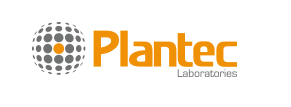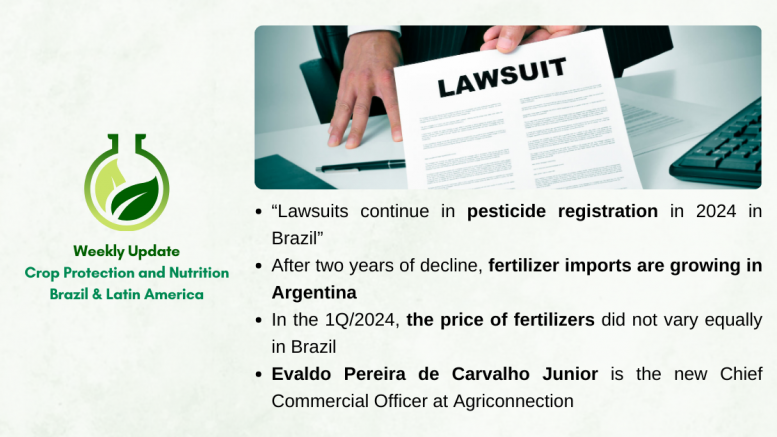Fertilizer deliveries have increased in January of 2024 in Brazil
Brazil
After nine years outside the segment, DVA Group is back to the agrochemical market in Brazil with the debut of the Agroallianz brand. The goal is to expand the portfolio to reach a turnover of more than US$ 100 million by 2028. “In 2023, it was US$ 8 million with the specialty segment alone, which is also recent. However, by 2025, the expectation with agrochemicals is that we will jump to US$ 25 million. That is, three times more every year,” said Fernando Fernandes, general director of Agroallianz S.A. (DVA)
“Lawsuits continue in pesticide registration in 2024″, said Flavio Hirata, from AllierBrasil, a pesticide registration consulting firm. “In the first three months of this year, there were 21 approvals through court decisions by Anvisa.” (AllierBrasil)
Walter Dias is the new Global Head of Research and Development at UPL. (UPL)
Nutriplant, which operates in the production of micronutrients and raw materials for industrial use, had a net revenue of US$ 35.5 million in 2023, up 2.4% from US$ 34.6 million in the previous year. (Nutriplant)
Fertilizer deliveries have increased in January of 2024, with a volume of 3.7 million tonnes, an increase of 8.3% compared to the same period in 2023, with 3.42 million tonnes. State of Mato Grosso leads, with 28.6% of total deliveries, followed by the States of Paraná (480 thousand tonnes), Goiás (403 thousand tonnes), Minas Gerais (344 thousand tonnes) and São Paulo (309 thousand tonnes). (ANDA)
Coffee exchange rates are good for the farmers, according to Jeferson Souza, market analyst at Agrinvest Commodities. “In the last 15 days, I noticed a good increase in grain prices, and as we didn’t have so many variations in fertilizer prices, the purchasing power of coffee farmers improved”, said Souza. “To illustrate, we have one of the best values for KCl [potassium chloride] in nine years for this period. In the case of urea, the scenario is also favorable… Another interesting fact is that coffee farms in Brazil consume 4.0% to 5.0% of the total volume of fertilizer delivered annually. For example, for soybeans, this percentage exceeds 40%”. (Agrinvest Commodities)
Adolpho Lemos is the new Strategic Partnerships Director for Brazil at Nutrien Soluções Agrícolas. (Nutrien Soluções Agrícolas)
Evaldo Pereira de Carvalho Junior is the new Chief Commercial Officer at Agriconnection. (Agriconnection)
Fertilizer Donation Program for family farming of the Department of Agriculture of the State of Minas Gerais has received participation requests from 146 interested municipalities. At least 10,000 tonnes of fertilizers will be supplied, with the expectation that about 2,000 farmers per year will benefit, covering nine regions of the State. “Soil correction with agricultural silicon increases the plant’s resistance against the attack of pests and diseases, increasing productivity by two or three times…”, said the Undersecretary of Agricultural Policy and Economics of the Department of Agriculture of Minas Gerais, Caio César Coimbra. (Seapa; Emater-MG; Harsco Environmental)
In the 1Q/2024, the price of fertilizers did not vary equally. Nitrogen, which is normally very volatile, showed fluctuations, but in the end had significant increases in the aggregate for the period. Phosphate prices practically did not change, remaining at the same level. In the case of potash, there was a devaluation in January and February, and price increases in March. Thus, in Brazil, urea prices increased by 13% in the quarter, while MAP [monoammonium phosphate] increased by 1% and KCl [potassium chloride] prices fell by 1%. (StoneX Consulting)
20 tonnes of irregular pesticides and materials for the production of another 120 tonnes of the input were seized in Caldas Novas, State of Goiás. Two places were inspected, containing irregular production and falsification of agrochemicals, as well as storage of products in large quantities and in a precarious manner. (MAPA)
Demetrius Cruz is the new head of public affairs, science and sustainability for Brazil at Bayer. (Bayer)
Government of the State of Amazonas has granted the first environmental license to install the potash exploration infrastructure in a mine owned by the company Potássio do Brasil (Brazil Potash Mining) in the city of Autazes, State of Amazonas. After all licenses are approved, this could become the second largest potash mine in the world. (Government of Amazonas)
AgroGalaxy, in partnership with fintech TerraMagna, has just concluded raising US$ 99.82 million to purchase pesticides. In 2023, the company spent US$ 67.8 million in cash and cash equivalents and ended the year with US$ 156.38 million in cash. (AgroGalaxy)
“For many years, farmers identified control of grass-type weeds as one of the main barriers to successful sorghum farming, often opting for other, more viable, crops”, according to Fernanda de Souza Antonio , marketing coordinator at Orígeo, a joint venture between Bunge and UPL. According to Souza, 68 herbicides are registered for sorghum farming, made up of nine different active ingredients. “Of these, 52 products are intended for the control of narrow leaves/grasses, represented by only five active ingredients: Atrazine (42) Dimethylamine (1) Glyphosate (5) S-metolachlor (3) Imazapic + imazethapyr (1)”. (Orígeo)

Latin America
After two years of decline, fertilizer imports are growing in Argentina. In January and February, 160,000 tonnes of urea and 32,000 tonnes of monoammonium phosphate (MAP) were imported, a record amount. (AZ Group)
According to a report by the Asociación Nacional de Empresarios de Colombia, Sucroal, a chemical and biotechnology company, is the fourth largest exporter of chemical substances in the country. The company’s revenue grew 13.5% in 2023 compared to the same period a year ago, from US$ 54.7 million to US$ 62.1 million. The company’s performance was due to economic recovery, logistics and development, and exports. (ANDI)
Pesticides have been found in rodents in Jalisco, Mexico, in the agricultural areas with the most sugarcane. The analysis was carried out on the kidneys and livers of 120 animals, which were captured in sugarcane and corn farms, as well as in floodplain jungle areas, and all of them showed the presence of pesticides. Eight pesticides were identified, being four herbicides (ametryne, atrazine, molinate and picloram), three insecticides (carbofuran, diazinon and malathion) and one fungicide (thiabendazole). (CUCSur; Universidad de Guadalajara)
Small farmers’ crops were fumigated with drones in the valleys of Tumbes, Peru, through the Puyango Tumbes Binational Special Project. In order to optimize the prevention and control of agricultural pests and diseases, 77 hectares of crops have already been disinfected for the benefit of 33 farmers in the Zarumilla Valley. (Midagri)

READ MORE:

